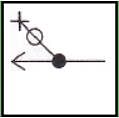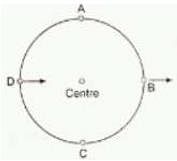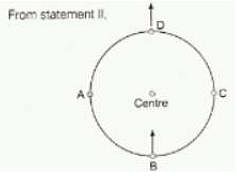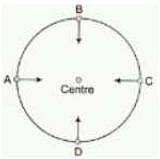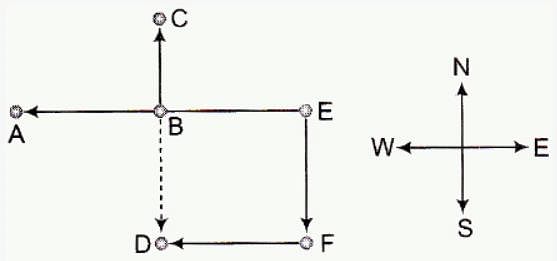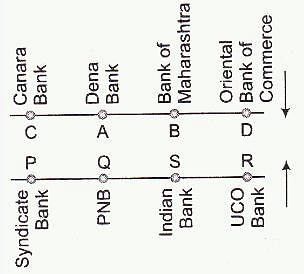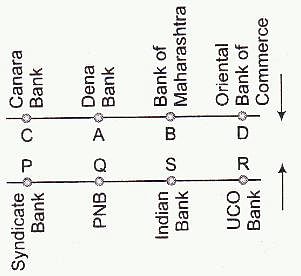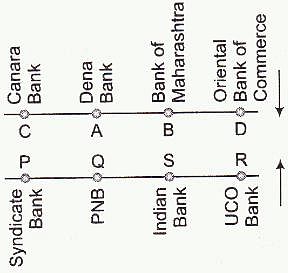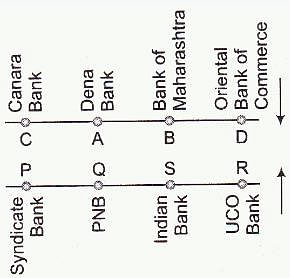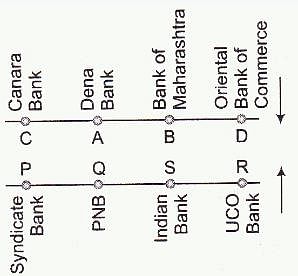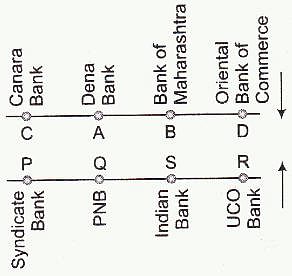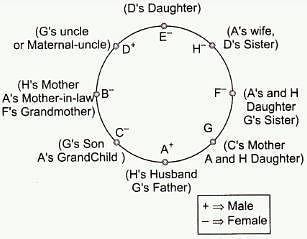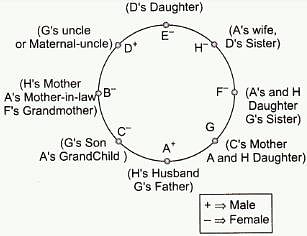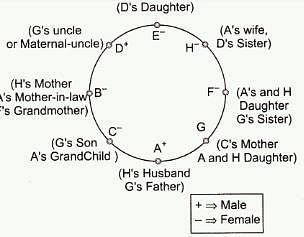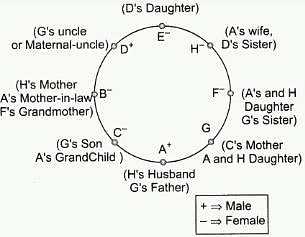SSC JE (ME) Mock Test - 6 - Mechanical Engineering MCQ
30 Questions MCQ Test SSC JE Mechanical Mock Test Series 2025 - SSC JE (ME) Mock Test - 6
Each of the questions below consists of a question and three statements numbered I, II, and III given below it. You have to decide whether the data provided in the statements are sufficient to answer the question. Read all three statements and Give an Answer.
Among six people P, Q, R, S, T, and V each lives on a different floor of a six-store building having six floors numbered one to six (the ground floor is numbered 1, the floor above it, number 2, and so on and the topmost floor is numbered 6). Who lives on the topmost floor?
I. There is only one floor between the floors on which R and Q live. P lives on an even-numbered floor.
II. T does not live on an even-numbered floor. Q lives on an even-numbered floor. Q does not live on the topmost floor.
III. S lives on an odd-numbered floor. There are two floors between the floors on which S and P live. T lives on a floor immediately above R's floor.
In each of the following questions below, the figures follow a series sequence. One and only one of the five figures do not fit in the series/sequence. The number of that figure is your answer.
| 1 Crore+ students have signed up on EduRev. Have you? Download the App |
In each of the questions given below, which one of the five answer figures on the right should come after the problem figures on the left if the sequence were continued?


Study the following information carefully and answer the given questions.
A word and number arrangement machine, when given an input line of words and numbers, arrangement them following a particular rule in each step. The following is an illustration of input and rearrangement.
(All the numbers are two digits numbers)
Input tall 48 13 rise alt 99 76 32 wise jar high 28 56 barn
Step I 13 tall 48 rise 99 76 32 wise jar high 28 56 barn alt
Step II 28 13 tall 48 rise 99 76 32 wise jar high 56 alt barn
Step III 32 28 13 tall 48 rise 99 76 wise jars 56 alt barn high
Step IV 48 32 28 13 tall rise 99 76 wise 56 alt barn high jar
Step V 56 48 32 28 13 tall 99 76 wise alt barn high jar rise
Step VI 76 56 48 32 28 13 99 wise alt barn high jar rise tall
Step VII 99 76 56 48 32 28 13 alt barn high jar rise tall wise, and Step VII is the last step of the above input, as the desired arrangement is obtained.
As per the rules followed in the above steps, find out the appropriate step for the given input in each of the following questions.
Input 84 why sit 14 32 not best ink feet 51 27 vain 68 92
(All the numbers are two digits numbers)
Which word/number would be at the 5th position from the right in Step V?
Study the following information carefully and answer the given questions.
A word and number arrangement machine, when given an input Line of words and numbers, arrangement them following a particular rule in each step. The following is an illustration of input and rearrangement.
(All the numbers are two digits numbers)
Input tall 48 13 rise alt 99 76 32 wise jar high 28 56 barn
Step I 13 tall 48 rise 99 76 32 wise jar high 28 56 barn alt
Step II 28 13 tall 48 rise 99 76 32 wise jar high 56 alt barn
Step III 32 28 13 tall 48 rise 99 76 wise jar 56 alt barn high
Step IV 48 32 28 13 tall rise 99 76 wise 56 alt barn high jar
Step V 56 48 32 28 13 tall 99 76 wise alt barn high jar rise
Step VI 76 56 48 32 28 13 99 wise alt barn high jar rise tall
Step VII 99 76 56 48 32 28 13 alt barn high jar rise tall wise, and Step VII is the last step of the above input, as the desired arrangement is obtained.
As per the rules followed in the above steps, find out in each of the following questions the appropriate step for the given input.
Input 84 why sit 14 32 not best ink feet 51 27 vain 68 92
(All the numbers are two digits numbers)
Which of the following represents the position of 'why' in the fourth step?
Study the following information carefully and answer the given questions.
A word and number arrangement machine, when given an input Line of words and numbers, arrangement them following a particular rule in each step. The following is an illustration of input and rearrangement.
(All the numbers are two digits numbers)
Input tall 48 13 rise alt 99 76 32 wise jar high 28 56 barn
Step I 13 tall 48 rise 99 76 32 wise jar high 28 56 barn alt
Step II 28 13 tall 48 rise 99 76 32 wise jar high 56 alt barn
Step III 32 28 13 tall 48 rise 99 76 wise jar 56 alt barn high
Step IV 48 32 28 13 tall rise 99 76 wise 56 alt barn high jar
Step V 56 48 32 28 13 tall 99 76 wise alt barn high jar rise
Step VI 76 56 48 32 28 13 99 wise alt barn high jar rise tall
Step VII 99 76 56 48 32 28 13 alt barn high jar rise tall wise and Step VII is the last step of the above input, as the desired arrangement is obtained
As per the rules followed in the above steps, find out in each of the following questions the appropriate step for the given input.
Input 84 why sit 14 32 not best ink feet 51 27 vain 68 92
(All the numbers are two digits numbers)
Which step number is the following output?
9227 14 84 why sit not 51 vain 92 68 feet best ink
Study the following information carefully and answer the given questions.
A word and number arrangement machine, when given an input Line of words and numbers, arrangement them following a particular rule in each step. The following is an illustration of input and rearrangement.
(All the numbers are two digits numbers)
Input tall 48 13 rise alt 99 76 32 wise jar high 28 56 barn
Step I 13 tall 48 rise 99 76 32 wise jar high 28 56 barn alt
Step II 28 13 tall 48 rise 99 76 32 wise jar high 56 alt barn
Step III 32 28 13 tall 48 rise 99 76 wise jar 56 alt barn high
Step IV 48 32 28 13 tall rise 99 76 wise 56 alt barn high jar
Step V 56 48 32 28 13 tall 99 76 wise alt barn high jar rise
Step VI 76 56 48 32 28 13 99 wise alt barn high jar rise tall
Step VII 99 76 56 48 32 28 13 alt barn high jar rise tall wise and Step VII is the last step of the above input, as the desired arrangement is obtained.
As per the rules followed in the above steps, find out in each of the following questions the appropriate step for the given input.
Input 84 why sit 14 32 not best ink feet 51 27 vain 68 92
(All the numbers are two digits numbers)
How many elements (words or numbers) are there between 'feet' and '32' as they appear in the last step of the output?
Each of the questions below consists of a question and three statements numbered I, II, and III given below it. You have to decide whether the data provided in the statements are sufficient to answer the question. Read all three statements and Give an Answer.
Are all the four friends viz. A, B, C, and D, who are sitting around a circular table, facing the center?
I. B sits second to the right of D. D faces the center. C sits to the immediate right of both B and D.
II. A sits to the immediate left of B. C is not an immediate neighbour of A. C sits to the immediate right of D.'
III. D is an immediate neighbor of both A and C' B sits to the immediate left of A. C sits to the immediate right of B.
Each of the questions below consists of a question and three statements numbered I, II, and III given below it. You have to decide whether the data provided in the statements are sufficient to answer the question. Read all three statements and Give an Answer.
How is 'one' coded in the code language?
I. 'one of its kind is coded as 'zo pi ko fe' and 'in kind and cash' is coded as 'ga to ru ko.'
II. 'its point for origin' is coded as 'ba le fe mi' and 'make a point clear' is coded as 'yu si mi de.'
Kind sake money and cash arean coded as 'to mi ru hy' and 'money of various kinds coded as'qu ko zo hy.'
Each of the questions below consists of a question and three statements numbered I, II, and III given below it. You have to decide whether the data provided in the statements are sufficient to answer the question. Read all three statements and Give an Answer.
Point D is in which direction with respect to Point B?
I. Point A is to the West of point B. Point C is to the North of point B. Point D is to the South of point C.
II. Point G is to the South of point D. Point G is 4 m from point B. Point D is 9 m from point B.
III. Point A is to the West of point B. Point B is exactly midway between points A and E. point F is to the South of point E. Point D is to the West of point F.
In each of the questions given below, which one of the five answer figures on the right should come after the problem figures on the left if the sequence were continued?

Each of the questions below consists of a question and three statements numbered I, II, and III given below it. You have to decide whether the data provided in the statements are sufficient to answer the question. Read all three statements and Give an Answer.
There are six letters W, A, R, S, N, and E. Is 'ANSWER' the word formed after performing the following operations using these six letters only?
I. E is placed fourth to the right of A. S is not placed immediately next to either A or E.
II. R is placed immediately next (either left or right) to E. W is placed immediately next (either left or right) to S.
III. Both N and W are placed immediately next to S. The word does not begin with R. A is not placed immediately next to W.
In each of the following questions below, the figures follow a series sequence. One and only one of the five figures do not fit in the series /sequence. The number of that figure is your answer.
In each of the following questions below, the figures follow a series sequence. One and only one of the five figures do not fit in the series sequence. The number of that figure is your answer.
Study the following information carefully to answer the given questions
Eight persons from different banks viz. UCO Bank, Syndicate Bank, Canara Bank, PNB, Dena Bank, Oriental Bank of Commerce, Indian Bank, and Bank of Maharashtra are sitting in two parallel rows containing four people each, in such a way that there is an equal distance between adjacent persons. In row-1, A, B, C, and D are seated, and all of them are facing South' In row-2, P, Q, R, and S are seated, and all of them are facing North. Therefore, each member seated in a row faces another member of the other row in the given seating arrangement.
(All the information given above does not necessarily represent the order of seating as in the final arrangement)
C sits second to the right of the person from the Bank of Maharashtra. R is an immediate neighbor of the person who faces the person from the Bank of Maharashtra.
Only one person sits between R and the person for PNB. Immediate neighbor of the person from PNB faces the person from Canara Bank.
The person from UCO bank faces the person from Oriental Bank of Commerce. R is not from Oriental Bank of Commerce. P is not from PNB. P does not face the person from the Bank of Maharashtra.
Q faces the person from Dena Bank. The one who faces S sits to the immediate left of A.
B does not sit at any of the extreme ends of the line. The person from the Bank of Maharashtra does not face the person from Syndicate Bank.
Who among the following sit at extreme ends of the rows?
Study the following information carefully to answer the given questions
Eight persons from different banks viz. UCO Bank, Syndicate Bank, Canara Bank, PNB, Dena Bank, Oriental Bank of Commerce, Indian Bank, and Bank of Maharashtra are sitting in two parallel rows containing four people each, in such a way that there is an equal distance between adjacent persons. In row-1, A, B, C, and D are seated, and all of them are facing South' In row-2, P, Q, R, and S are seated, and all of them are facing North. Therefore, each member seated in a row faces another member of the other row in the given seating arrangement.
(All the information given above does not necessarily represent the order of seating as in the final arrangement)
C sits second to right of the person from Bank of Maharashtra. R is an immediate neighbor of the person who faces the person from Bank of Maharashtra.
Only one person sits between R and the person for PNB. Immediate neighbor of the person from PNB faces the person from Canara Bank.
The person from UCO Bank faces the person from Oriental Bank of Commerce. R is not from Oriental Bank of Commerce. P is not from PNB. P does not face the person from the Bank of Maharashtra.
Q faces the person from Dena Bank. The one who faces S sits to the immediate left of A.
B does not sit at any of the extreme ends of the line. The person from the Bank of Maharashtra does not face the person from Syndicate Bank.
Who among the following is from Syndicate Bank?
Study the following information carefully to answer the given questions
Eight persons from different banks viz. UCO Bank, Syndicate Bank, Canara Bank, PNB, Dena Bank, Oriental Bank of Commerce, Indian Bank, and Bank of Maharashtra are sitting in two parallel rows containing four people each, in such a way that there is an equal distance between adjacent persons. In row-1, A, B, C, and D are seated, and all of them are facing South' In row-2, P, Q, R, and S are seated, and all of them are facing North. Therefore, each member seated in a row faces another member of the other row in the given seating arrangement.
(All the information given above does not necessarily represent the order of seating as in the final arrangement)
C sits second to right of the person from Bank of Maharashtra. R is an immediate neighbor of the person who faces the person from Bank of Maharashtra.
Only one person sits between R and the person for PNB. Immediate neighbor of the person from PNB faces the person from Canara Bank.
The person from UCO Bank faces the person from Oriental Bank of Commerce. R is not from Oriental Bank of Commerce. P is not from PNB. P does not face the person from Bank of Maharashtra.
Q faces the person from Dena Bank. The one who faces S sits to the immediate left of A.
B does not sit at any of the extreme ends of the line. The person from Bank of Maharashtra does not face the person from Syndicate Bank.
Which of the following is true regarding A?
Study the following information carefully to answer the given questions
Eight persons from different banks viz. UCO Bank, Syndicate Bank, Canara Bank, PNB, Dena Bank, Oriental Bank of Commerce, Indian Bank, and Bank of Maharashtra are sitting in two parallel rows containing four people each, in such a way that there is an equal distance between adjacent persons. In row-1, A, B, C, and D are seated, and all of them are facing South' In row-2, P, Q, R, and S are seated, and all of them are facing North. Therefore, each member seated in a row faces another member of the other row in the given seating arrangement.
(All the information given above does not necessarily represent the order of seating as in the final arrangement)
C sits second to right of the person from Bank of Maharashtra. R is an immediate neighbor of the person who faces the person from Bank of Maharashtra.
Only one person sits between R and the person for PNB. Immediate neighbor of the person from PNB faces the person from Canara Bank.
The person from UCO Bank faces the person from Oriental Bank of Commerce. R is not from Oriental Bank of Commerce. P is not from PNB. P does not face the person from Bank of Maharashtra.
Q faces the person from Dena Bank. The one who faces S sits to the immediate left of A.
B does not sit at any of the extreme ends of the line. The person from Bank of Maharashtra does not face the person from Syndicate Bank.
Who is seated between R and the person from PNB?
Study the following information carefully to answer the given questions
Eight persons from different banks viz. UCO Bank, Syndicate Bank, Canara Bank, PNB, Dena Bank, Oriental Bank of Commerce, Indian Bank, and Bank of Maharashtra are sitting in two parallel rows containing four people each, in such a way that there is an equal distance between adjacent persons. In row-1 A, B, C and D are seated and all of them are facing South' In row-2 P, Q, R and S are seated and all of them are facing North. Therefore, in the given seating arrangement each member seated in a row faces another member of the other row.
(All the information given above does not necessarily represent the order of seating as in the final arrangement)
C sits second to the right of the person from Bank of Maharashtra. R is an immediate neighbor of the person who faces the person from the Bank of Maharashtra.
Only one person sits between R and the person for PNB. Immediate neighbor of the person from PNB faces the person from Canara Bank.
The person from UCO bank faces the person from Oriental Bank of Commerce. R is not from Oriental Bank of Commerce. P is not from PNB. P does not face the person from the Bank of Maharashtra.
Q faces the person from Dena Bank. The one who faces S sits to the immediate left of A.
B does not sit at any of the extreme ends of the line. The person from the Bank of Maharashtra does not face the person from Syndicate Bank.
Four of the following five are alike in a certain way based on the given seating arrangement and thus form a group. Which is the one that does not belong to that group?
Study the following information carefully to answer the given questions
Eight persons from different banks viz. UCO Bank, Syndicate Bank, Canara Bank, PNB, Dena Bank, Oriental Bank of Commerce, Indian Bank, and Bank of Maharashtra are sitting in two parallel rows containing four people each, in such a way that there is an equal distance between adjacent persons. In row-1 A, B, C and D are seated and all of them are facing South' In row-2 P, Q, R and S are seated and all of them are facing North. Therefore, in the given seating arrangement each member seated in a row faces another member of the other row.
(All the information given above does not necessarily represent the order of seating as in the final arrangement)
C sits second to right of the person from Bank of Maharashtra. R is an immediate neighbor of the person who faces the person from Bank of Maharashtra.
Only one person sits between R and the person for PNB. Immediate neighbor of the person from PNB faces the person from Canara Bank.
The person from UCO Bank faces the person from Oriental Bank of Commerce. R is not from Oriental Bank of Commerce. P is not from PNB. P does not face the person from the Bank of Maharashtra.
Q faces the person from Dena Bank. The one who faces S sits to the immediate left of A.
B does not sit at any of the extreme ends of the line. The person from the Bank of Maharashtra does not face the person from Syndicate Bank.
Who among the following faces the person from the Bank of Maharashtra?
Study the following information carefully to answer the given questions
Eight persons from different banks viz. UCO Bank, Syndicate Bank, Canara Bank, PNB, Dena Bank, Oriental Bank of Commerce, Indian Bank, and Bank of Maharashtra are sitting in two parallel rows containing four people each, in such a way that there is an equal distance between adjacent persons. In row-1 A, B, C and D are seated and all of them are facing South' In row-2 P, Q, R and S are seated and all of them are facing North. Therefore, in the given seating arrangement, each member seated in a row faces another member of the other row.
(All the information given above does not necessarily represent the order of seating as in the final arrangement)
C sits second to right of the person from Bank of Maharashtra. R is an immediate neighbor of the person who faces the person from Bank of Maharashtra.
Only one person sits between R and the person for PNB. Immediate neighbor of the person from PNB faces the person from Canara Bank.
The person from UCO bank faces the person from Oriental Bank of Commerce. R is not from Oriental Bank of Commerce. P is not from PNB. P does not face the person from the Bank of Maharashtra.
Q faces the person from Dena Bank. The one who faces S sits to the immediate left of A.
B does not sit at any of the extreme ends of the line. The person from the i.e.the k of Maharashtra does not face the person from Syndicate Bank.
P is related to Dena Bank in the same way as B is related to PNB based on the given arrangement. To who among the following is D related to, following the same pattern?
Study the following information carefully to answer the given questions
Eight persons from different banks viz. UCO Bank, Syndicate Bank, Canara Bank, PNB, Dena Bank, Oriental Bank of Commerce, Indian Bank and Bank of Maharashtra are sitting in two parallel rows containing four people each, in such a way that there is an equal distance between adjacent persons. In row-1 A, B, C and D are seated and all of them are facing South' In row-2 P, Q, R and S are seated and all of them are facing North. Therefore, in the given seating arrangement each member seated in a row faces another member of the other row.
(All the information given above does not necessarily represent the order of seating as in the final arrangement)
C sits second to right of the person from Bank of Maharashtra. R is an immediate neighbor of the person who faces the person from Bank of Maharashtra.
Only one person sits between R and the person for PNB. Immediate neighbor of the person from PNB faces the person from Canara Bank.
The person from UCO Bank faces the person from Oriental Bank of Commerce. R is not from Oriental Bank of Commerce. P is not from PNB. P does not face the person from Bank of Maharashtra.
Q faces the person from Dena Bank. The one who faces S sits to the immediate left of A.
B does not sit at any of the extreme ends of the line. The person from Bank of Maharashtra does not face the person from Syndicate Bank.
C is from which of the following banks?
In each of the questions given below which one of the five answer figures on the right should come after the problem figures on the left if the sequence were continued?

In each of the following questions below, the figures follow a series sequence. One and only one of the five figures does not fit in the series sequence. The number of that figure is your answer.
In each of the questions given below,,which one of the five answer figures on the right should come after the problem figures on the left if the sequence were continued?

Study the following information carefully and answer the given questions.
A, B, C, D, E, F, G and H are sitting around a circle facing the center but not necessarily in the same order.
B sits second to the left of H's husband. No female is an immediate neighbour of B.
D's daughter sits second to the right of F. F is the sister of G. F is not an immediate neighbour of H's.
Only one person sits between A and F. A is the father of G. H's brother D sits to the immediate left of H's mother'.
Only one person sits between H's mother and E.
Only one person sits between H, and G. G is the mother of C. G is not an immediate neighbour of E.
What is the position of A with respect to his grandchild?
Study the following information carefully and answer the given questions.
A, B, C, D, E, F, G, and H are sitting around a circle facing the center but not necessarily in the same order.
B sits second to the left of H's husband. No female is an immediate neighbour of B.
D's daughter sits second to the right of F. F is the sister of G. F is not an immediate neighbour of H's.
Only one person sits between A and F. A is the father of G. H's brother D sits to the immediate left of H's mother'.
Only one person sits between H's mother and E.
Only one person sits between H, and G. G is the mother of C. G is not an immediate neighbour of E.
Who sits to the immediate left of C?
Study the following information carefully and answer the given questions.
A, B, C, D, E, F, G, and H are sitting around a circle facing the center but not necessarily in the same order.
B sits second to the left of H's husband. No female is an immediate neighbour of B.
D's daughter sits second to the right of F. F is the sister of G. F is not an immediate neighbour of H's.
Only one person sits between A and F. A is the father of G. H's brother D sits to the immediate left of H's mother'.
Only one person sits between H's mother and E.
Only one person sits between H, and G. G is the mother of C. G is not an immediate neighbour of E.
Four of the following five are alike in a certain way based on the given information, and so form a group. Which is the one that does not belong to that group?
Study the following information carefully and answer the given questions.
A, B, C, D, E, F, G, and H are sitting around a circle facing the center but not necessarily in the same order.
B sits second to the left of H's husband. No female is an immediate neighbour of B.
D's daughter sits second to the right of F. F is the sister of G. F is not an immediate neighbour of H's.
Only one person sits between A and F. A is the father of G. H's brother D sits to the immediate left of H's mother'.
Only one person sits between H's mother and E.
Only one person sits between H, and G. G is the mother of C. G is not an immediate neighbour of E.
What is the position of A with respect to his mother-in-law?
Study the following information carefully and answer the given questions.
A, B, C, D, E, F, G, and H are sitting around a circle facing the center but not necessarily in the same order.
B sits second to the left of H's husband. No female is an immediate neighbour of B.
D's daughter sits second to the right of F. F is the sister of G. F is not an immediate neighbour of H's.
Only one person sits between A and F. A is the father of G. H's brother D sits to the immediate left of H's mother'.
Only one person sits between H's mother and E.
Only one person sits between H, and G. G is the mother of C. G is not an immediate neighbour of E.
How many people sit between G and her uncle?
|
3 videos|1 docs|55 tests
|
|
3 videos|1 docs|55 tests
|


